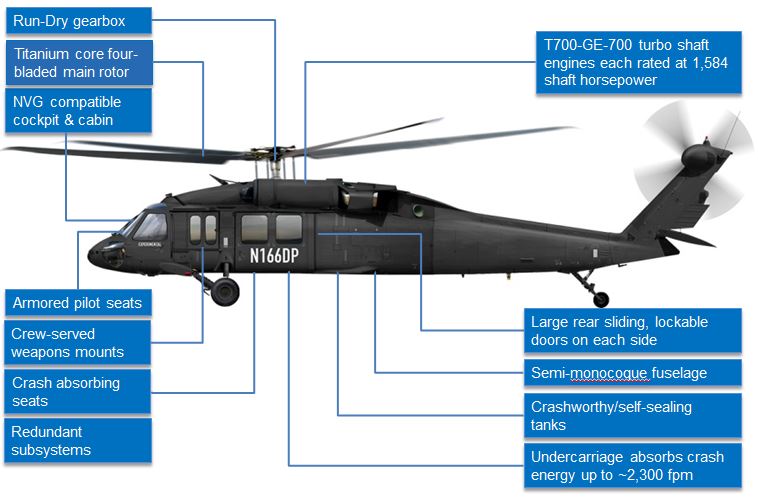Attaining Quality: Secret Methods for UH 60 Helicopter Maintenance
Attaining Quality: Secret Methods for UH 60 Helicopter Maintenance
Blog Article
Comprehending the Mechanics and Design Behind Uh 60 Helicopters
The UH-60 helicopter, typically understood as the Black Hawk, stands as a peak of contemporary rotorcraft innovation, personifying a mix of durable design and intricate mechanics. As we peel back the layers of the UH-60's style, a world of detailed systems and meticulous design comes to light.
History of UH-60 Helicopters
The history of UH-60 helicopters traces back to the late 1970s when the United States Army sought a advanced and functional utility helicopter to replace its aging fleet. In reaction to this need, the Sikorsky Airplane Company established the UH-60 Black Hawk helicopter. Presented in 1979, the UH-60 promptly ended up being a staple in armed forces operations as a result of its excellent abilities.
The UH-60 was made to master a variety of goals, consisting of troop transportation, medical discharge, electronic warfare, and unique operations. Its capacity to adjust to different roles made it a beneficial possession to the U.S. uh 60. Military and other military pressures around the globe
For many years, the UH-60 platform has actually undertaken a number of upgrades and variations to improve its performance and equal evolving goal requirements. These helicopters have actually seen comprehensive solution in disputes such as the Gulf War, Afghanistan, and Iraq, showcasing their integrity and versatility in diverse functional environments. The UH-60's rich history is a testimony to its long-lasting tradition as a top utility helicopter.

Engine and Power Solutions
Using advanced propulsion technology, UH-60 helicopters are equipped with sophisticated engine and power systems to guarantee optimum performance and integrity in a series of functional circumstances. The UH-60, frequently referred to as the Black Hawk, is powered by two General Electric T700-GE-701D engines, each efficient in delivering up to 1,940 shaft horsepower. These turboshaft engines offer the needed drive for the helicopter to perform its missions properly, consisting of army transportation, clinical discharge, and battle assistance.

Blades System and The Rules Of Aerodynamics
How do the rotor system and aerodynamics of UH-60 helicopters add to their operational effectiveness and flight abilities? The blades system of the UH-60 helicopter plays a crucial duty in providing lift and propulsion. The UH-60 includes a four-bladed, totally expressed blades system that enables high ability to move and security throughout flight. This layout makes it possible for the helicopter to do a variety of missions, from transport and clinical emptying to battle procedures.
Aerodynamics also play a vital function in the performance of UH-60 helicopters. The structured fuselage and rotor blade design reduce drag, permitting the helicopter to accomplish higher rates and much better fuel efficiency. The wind resistant style of the UH-60 also adds to its Bonuses capability to run in diverse ecological conditions, consisting of high elevations and hot temperature levels.
Avionics and Flight Control Equipment

In its detailed control with the blades system and aerodynamics of UH-60 helicopters, the avionics and flight control systems develop a vital network of technologies shaping the aircraft's operational abilities. In the UH-60, these systems include digital displays, communication radios, GPS navigation, climate radar, and autopilot systems.
The flight control systems of the UH-60 are in charge of equating the pilot's inputs right into the ideal adjustments to the rotor system, making sure secure trip and ability to move. These systems include hydraulic actuators, servos, and computer systems that interact to control the main and tail rotors, as well as various other trip control surface areas. By precisely managing the helicopter's trip characteristics, these systems allow pilots to do a vast array of goals, from transportation and search-and-rescue to battle procedures, with check here precision and click to read more confidence.
Role and Applications in Aviation
The role and applications of avionics and flight control systems in aviation are important to making certain the secure and reliable operation of aircraft, consisting of UH-60 helicopters. Avionics systems in UH-60 helicopters include a series of electronic systems that aid in navigating, interaction, tracking, and regulating numerous airplane functions. These systems consist of electronic screens, auto-pilot systems, interaction radios, GPS navigation tools, and climate radar. Flight control systems play an important function in steering the helicopter in the air, preserving stability, and guaranteeing exact activities. The fly-by-wire innovation used in contemporary UH-60 helicopters translates pilot inputs into digital signals, which are then interpreted by the trip control computers to adjust the aircraft's control surface areas. Furthermore, these systems incorporate security features such as auto-pilot modes, terrain recognition cautioning systems, and security augmentation systems to boost the general safety and functional abilities of the UH-60 helicopters in different missions, consisting of army transportation, medical discharge, search and rescue, and aerial firefighting.
Conclusion
In conclusion, the UH-60 helicopter is a versatile aircraft with an abundant history and advanced engineering. Its engine and power systems, rotor system, aerodynamics, avionics, and trip control systems all function together to make it a efficient and reliable machine.
In its intricate coordination with the blades system and the rules of aerodynamics of UH-60 helicopters, the avionics and flight control systems develop a vital network of innovations shaping the airplane's functional abilities.The flight control systems of the UH-60 are responsible for translating the pilot's inputs right into the proper changes to the blades system, making sure steady flight and maneuverability. Avionics systems in UH-60 helicopters incorporate an array of digital systems that help in navigation, interaction, surveillance, and managing various airplane features. In addition, these systems integrate safety attributes such as auto-pilot modes, surface recognition alerting systems, and stability enhancement systems to improve the overall safety and security and functional abilities of the UH-60 helicopters in various goals, including army transport, medical discharge, search and rescue, and airborne firefighting.
Its engine and power systems, rotor system, the rules of aerodynamics, avionics, and flight control systems all function together to make it a reliable and reliable machine.
Report this page